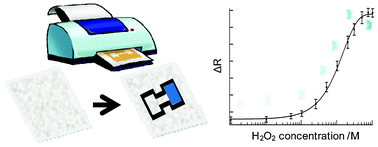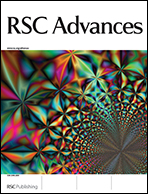Inkjet printing: an integrated and green chemical approach to microfluidic paper-based analytical devices†
Abstract
This paper describes a new method for the fabrication of microfluidic paper-based analytical devices (μPADs) by inkjet printing alone. Microfluidic structures are patterned within less than 5 min on the surface of untreated filter paper by printing a hydrophobic UV curable acrylate composition made of non-volatile and not readily flammable compounds. After ink penetration into the paper and UV curing for 60 s, hydrophobic barriers are formed. Microfluidic channels as narrow as 272 ± 19 μm are achieved. Printed patterns retain their aqueous liquid guiding functionality for at least 6 months when stored at room temperature and for at least 72 h at 50 °C. Printing a thin uniform film on the top of the paper allows the creation of protective layers, resulting in “tunnel-like” sections of microfluidic channels entirely surrounded by inkjet printed hydrophobic barriers. Finally, the same inkjet printer is used to print reagents necessary for colorimetric sensing, which is demonstrated in the example of an enzymatic H2O2 sensor. The detection limit of the μPAD for aqueous H2O2 is 14.4 μM when applying colorimetric data processing. The only equipment required for the entire μPAD fabrication process is an off-the-shelf inkjet printer and a UV light source. This is the first application of standard printing technology for the fully integrated fabrication (microfluidic pattern, back cover, variable pattern depth, enclosed microfluidic structures, biosensor) of entire μPADs.


 Please wait while we load your content...
Please wait while we load your content...